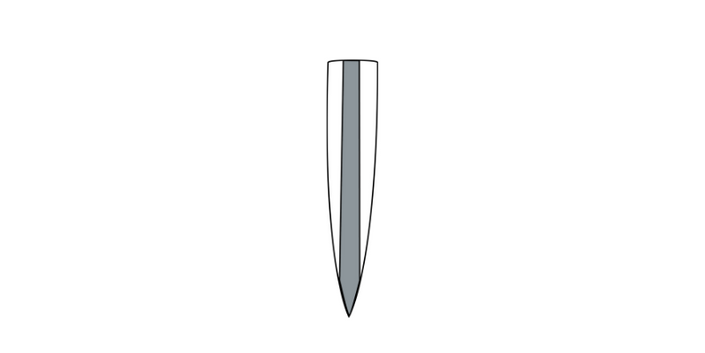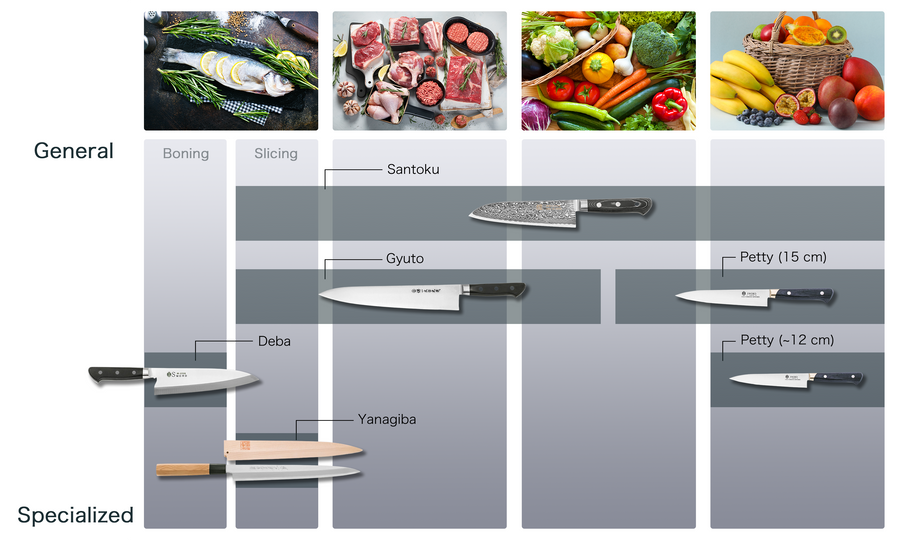
Kiyoshi Series
Our Kiyoshi Series has a “pear's skin” Nashiji finished surface, with the satin-like surface retaining the warm of handmade craftsmanship. The narrow blade combined with the famous "hamaguri" shape seen in high end Japanese kitchen knives reduces cutting resistance, creating a high-performance knife. These knives are made in the famous knife making region of Tsubame-Sanjo, which is also where the Kiyoshi namesake is inspired from. Seibei Otani (大谷清兵衛) was a magistrate who promoted Japanese nail making as a side job for farmers who suffered from the flooding of the Igarashi River in 1625. He did this by inviting Japanese nail artisans from Edo to upskill the farmers into craftsmanship and improve their work quality. This event helped turn Tsubame-Sanjo into a region famous for metalworking and toolmaking even today. Kiyoshi (清) is a kanji character used in Otani’s name, and is our way to honor him.
| Product number | Actual Blade Length (mm) | Full Length (mm) | Total Weight (g) |
|---|---|---|---|
| kiyoshib-165 | 165 | 305 | 140 |
| Blade | Material Name | Handle |
|---|---|---|

Double Edged |
Blue Steel #2 | Oak |

Wa-Santoku
A Wa-Santoku is typically used in households around Japan. Unlike the standard Santoku, the Wa-Santoku has a traditional Japanese handle which shifts the balance point slightly,allowing more nimble cutting.

Blue Steel #2
Adding tungsten, chromium, and alloy carbides to White Steel makes for a tough, chip-resistant blade.
Carbon Steel
Blue Steel #2 is made by adding trace amounts of tungsten and alloy carbides (both for hardness), and chromium (for toughness and rust resistance) to White Steel, creating an alloy steel that is very tightly bonded. This also leads to better edge retention compared to White Steel #2, so you can cut better for longer. Professional chefs looking to enter the next level of quality will often choose a Blue Steel #2 knife, but beginners can use this also.
*NOTE: Carbon Steel is susceptible to rust if it is not properly cared for. Please clean and dry the blade regularly during use and after use.

Clad
Clad knives are made from a steel plate that has a core steel sandwiched between soft iron. It is then shaped, hardened, and polished. This method is often used for knives focused on cost performance, as they are easier to remove distortions form and process.

Optional Engraving
Optional Engraving Service
Sakai Ichimonji provides complimentary engraving using either Japanese Kanji or English Alphabet. Please specify your preference. For details, please visit here
A knife store that has supported the history of knives and food culture in Japan.
It has been 600 years since the birth of swordmaking in the Sakai region of Japan. Sakai Ichimonji Mitsuhide's and it's craftsmen continue to build on that legacy by producing the finest blades in Japan.
This is where the culture of completing a dish of sashimi by "just cutting" and the culture of expressing sharpness as "taste" was born.
For 70 years, we have been connecting the spirit of Sakai's craftsmen with the passion of chefs in Osaka's kitchen equipment shopping district, known as the kitchen of Japan.
We are very happy that our knives can be used by people all over the world.
Precautions
After use, wash off any dirt and wipe thoroughly with a dry cloth to remove any moisture. This product is not for use with frozen foods.This product is handmade, so each piece will be different. Please use the weight and length listed as a guide. Each material is natural and may vary in color. It is not the same as the picture.We take great care with our inventory, but in the unlikely event that we are out of stock, we will contact you by email to let you know.
































